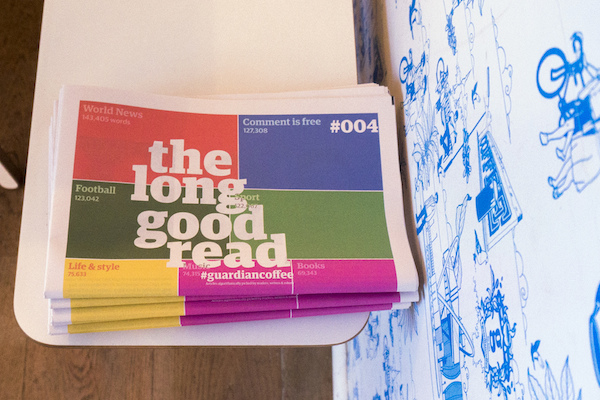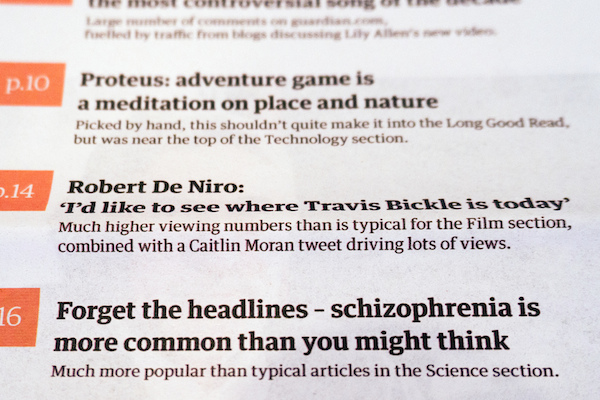
The Guardian is experimenting in the craft newspaper business and getting some help from robots.
That may sound odd, given that the company prints a daily paper read throughout Britain. A paper staffed by humans. But the company is tinkering with something smaller and more algorithm-driven.
The Guardian has partnered with The Newspaper Club, a company that produces small-run DIY newspapers, to print The Long Good Read, a weekly print product that collects a handful of The Guardian’s best longform stories from the previous seven days. The Newspaper Club runs off a limited number of copies, which are then distributed at another Guardian experiment: a coffee shop in East London. That’s where, on Monday mornings, you’ll find a 24-page tabloid with a simple layout available for free.
On the surface, The Long Good Read has the appeal of being a kind of analog Instapaper for all things Guardian. But the interesting thing is how paper is produced: robots. Okay, algorithms if you want to be technical — algorithms and programs that both select the paper’s stories and lay them out on the page.
Jemima Kiss, head of technology for The Guardian, said The Long Good Read is another attempt at finding ways to give stories new life beyond the day they’re published: “It’s just a way of reusing that content in a more imaginative way and not getting too hung up on the fact it’s a newspaper.”
The Long Good Read began life several years ago as a digital-only experiment from former Guardian developer Dan Catt. The idea was to harvest the paper’s feature pieces and longer stories into a stream of articles best meant for RSS or a read-it-later queue. These were the stories that lent themselves to dedicated reading time, that quiet moment after work or a lazy Saturday morning. That, Kiss said, also fits the description of print: “It’s part of a noble heritage: people wanting something to read when they’re drinking their coffee or tea.”

Catt built an algorithm that scans The Guardian’s API, stripping away blog posts, multimedia, and other pieces in favor of articles over a certain length. Here’s a good explanation:
We plundered those tools for data and wrote our own little “robot” (a bunch of algorithms) to surface what we hoped would be good, interesting, sometimes funny, sometimes long articles. Just before I throw together a new issue of this paper I can head off to our dashboard that presents me with about 30 “top” articles, about 1% of all articles originally published by the Guardian.
The robot does the legwork, leaving an editor to pick and choose what stories work for the edition before handing the process off to a different robot. In this case, it’s The Newspaper Club’s ARTHR tool, a layout program that lets people feed in content from different sources, either links or individual text and images. Tom Taylor, head of engineering for The Newspaper Club, said they use a semi-automated version of ARTHR for The Long Good Read, which allows an editor to enter story links and lets the program develop the layout on its own.
It’s a human-robot workflow that makes putting together a customized newspaper a quick process. The Long Good Read is sent to the printer on Friday and delivered fresh on Monday, Taylor said. “It becomes possible to make a paper in an hour that you can put in a coffee shop and have 500 copies,” Taylor said.

The Newspaper Club started four years ago as a kind of bespoke printing business. It’s a story about technology — the ARHTR tool, which simplifies the layout process for people who may not be familiar with Adobe InDesign — but also about the printing itself. The Newspaper Club specializes in smaller runs of newspapers (as few as one to five copies) using digital printing and traditional printing. The key, Taylor says, is bundling together groups of orders to help keep the costs low and allow people to print as few editions as they want. In the beginning, the minimum amount of newspapers they could run was 1,000 copies, but thanks to changes in printing tech and growth in business, that number has slowly slid to 300, to 50, and now as low as a single paper.
“It’s like the miniaturization of the engine, taking it down from a factory-sized thing to inside a car, to a motorbike. It changes what’s possible to do with an engine,” Taylor told me.

The Newspaper Club is part boutique, part newspaper collaborative, doing work for individuals (newspaper-themed weddings, perhaps?), photographers, or the London Philharmonic Orchestra. Some U.S. newspaper owners have tried to increase their commercial printing business, increasingly by printing their competitor’s papers. But Newspaper Club thinks smaller, and more personal, than the weekly coupon circular and hardware catalog.
“We’re straddling two worlds: the nostalgia for print and those beautiful machines, the rudiments of it all and the slightly more weird media future that is going on,” Taylor said. “It’s not as simple as ‘The Internet will replace print.’ The future is way more complicated than that.”
While technology has upended the traditional newspaper model, Taylor said it’s changed the economics in the favor of letting print lovers experiment with the medium. Things like The Newspaper Club aren’t meant to replace the traditional daily, but instead to see how the form can be customized and personalized, Taylor said. The appetite for reading longer, more in-depth articles exists, as well as the desire to get away from the screens we surround ourselves with, Taylor said. “I have no particular nostalgia for print. But I see it being very useful for certain things,” he said. “It does things you can’t do with a tablet or a screen.”

At the moment, The Guardian is planning a limited run of The Long Good Read before figuring out whether to continue the project; there’s no contract term between the two companies. Kiss said the paper fit in well with The Guardian’s other experiment, the coffee shop, which was also meant to be a different (real-life) venue for news and conversations. It all fits into The Guardian’s larger mission of open journalism and engaging with the public. “It’s not a new revenue stream — it’s much more experimental than that,” said Kiss. “It’s to see what happens. I think media organizations need to be more lightfooted in what they experiment with.”
For a company that has pushed itself to expand digitally around the globe, a move into print could seem like a backwards move. But print, like other technologies, has its own assortment of benefits and drawbacks, Kiss said. What The Long Good Read does is take some of the features of customization and story curation — attributes we would think of as webby — and push them into print. What’s important is giving people as many options for reading as possible, she said: “It’s not the medium that’s in trouble; it’s the business model.”
Photos from The Newspaper Club used under a Creative Commons license.